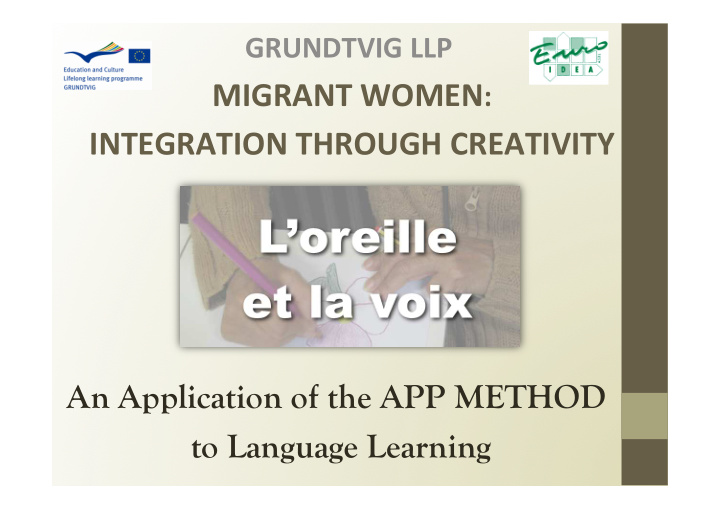



GRUNDTVIG ¡LLP ¡ ¡ MIGRANT ¡WOMEN : ¡ ¡ INTEGRATION ¡THROUGH ¡CREATIVITY ¡ ¡ An Application of the APP METHOD to Language Learning
The ¡ EURO-‑IDEA ¡ Associa/on ¡ in ¡ partnership ¡ with ¡ the ¡ Department ¡ of ¡ Equal ¡ Opportuni/es ¡ of ¡ Schaerbeek ¡ (Bruxelles ), ¡ organizes ¡ French ¡ courses ¡ using ¡ the ¡ APP ¡ Approach . ¡ These ¡ courses ¡ are ¡ meant ¡ for ¡ immigrant ¡mothers ¡of ¡school-‑age ¡children ¡ Madame ¡AFAF ¡HEMAMOU ¡ Echevine ¡de ¡l’egalité ¡hommes/femmes ¡
What ¡is ¡the ¡APP? ¡ The ¡Audio ¡Psycho ¡Phonology ¡is ¡a ¡ Method ¡developed ¡by ¡the ¡French ¡Ear ¡ Nose ¡and ¡Throat ¡specialist ¡Alfred ¡ TomaCs, ¡that ¡helps ¡the ¡‘language ¡ integraCon’ ¡process. ¡ The ¡idea ¡of ¡‘language ¡integraCon’ ¡ ¡ will ¡be ¡soon ¡explained ¡ ¡ ¡
¡Is ¡the ¡APP ¡just ¡a ¡‘new’ ¡language ¡ method? ¡ NO NO
Audio ¡Psycho ¡Phonology ¡ • The ¡name ¡Audio ¡Psycho ¡Phonology ¡refers ¡to ¡the ¡three ¡ funcCons ¡of ¡listening ¡– ¡sensory, ¡cogniCve ¡and ¡motor ¡– ¡that ¡ TomaCs ¡conjectured ¡to ¡be ¡linked ¡by ¡the ¡same ¡neural ¡network ¡
The ¡Tomatis ¡Effect ¡ (The ¡Fundamental ¡Law ¡of ¡APP) ¡ ¡ In ¡1953 ¡TomaCs ¡discovered ¡that ¡ "The ¡voice ¡does ¡not ¡produce ¡what ¡the ¡ear ¡does ¡not ¡hear” ¡ ¡
What ¡does ¡the ¡‘Tomatis ¡Effect’ ¡ actually ¡tell ¡us? ¡ ¡ • It ¡tells ¡us ¡that ¡not ¡only ¡ ¡the ¡perceptual ¡system ¡involved ¡in ¡ understanding ¡speech ¡is ¡closely ¡connected ¡to ¡the ¡motor ¡ system ¡through ¡which ¡speech ¡is ¡produced, ¡but ¡that, ¡in ¡turn, ¡ ¡ the ¡same ¡motor ¡system, ¡greatly ¡contributes ¡to ¡the ¡percepCon ¡ and ¡understanding ¡of ¡language ¡on ¡a ¡phonological, ¡semanCc ¡ and ¡syntacCc ¡level. ¡ • Basically ¡the ¡ear ¡is ¡a ¡ sensory ¡AND ¡a ¡motor ¡system ¡
The ¡development ¡of ¡ ¡ language ¡ • In ¡other ¡words ¡: ¡for ¡TomaCs, ¡the ¡percepCon ¡and ¡ understanding ¡of ¡speech ¡were ¡deeply ¡rooted ¡in ¡its ¡acCvaCon ¡ by ¡the ¡sensory ¡motor ¡system ¡(especially ¡by ¡the ¡auditory-‑ motor ¡system) ¡ • TomaCs ¡believed ¡that ¡language ¡could ¡only ¡develop ¡in ¡humans ¡ through ¡the ¡acCvaCon ¡of ¡neural ¡nervous ¡networks ¡connecCng ¡ percepCon, ¡acCon ¡and ¡cogniCon. ¡He ¡named ¡these ¡networks ¡ ‘listening ¡integrators’ ¡
It’s ¡all ¡about ¡Listening ¡ • NoCce ¡that ¡we ¡talk ¡about ¡the ¡‘LISTENING’ ¡integrators, ¡and ¡not ¡ about ¡‘HEARING’ ¡integrators ¡ You ¡could ¡hear ¡and ¡not ¡listen! ¡
Hearing ¡vs ¡Listening ¡ • Hearing ¡= ¡perceiving ¡sounds ¡ • Listening ¡= ¡perceiving ¡sounds ¡+ ¡paying ¡a]enCon ¡to ¡those ¡ sounds ¡ • Listening ¡can ¡be ¡defined ¡as ¡the ¡ability ¡to ¡adapt ¡to ¡the ¡constant ¡ changes ¡in ¡our ¡acousCc ¡environment ¡by ¡conCnuously ¡ readjusCng ¡the ¡content ¡and ¡form ¡of ¡the ¡messages ¡we ¡receive ¡ ¡ • It ¡is ¡possible ¡to ¡have ¡a ¡good ¡hearing ¡but ¡be ¡a ¡poor ¡listener. ¡ ¡
How ¡to ¡‘listen ¡well’ ¡ • In ¡order ¡for ¡the ¡listening ¡ funcCon ¡to ¡be ¡efficient, ¡our ¡ auditory ¡system ¡must ¡not ¡only ¡ be ¡able ¡to ¡constant ¡adapt ¡to ¡ the ¡changes ¡in ¡the ¡informaCon ¡ it ¡receives, ¡but, ¡based ¡on ¡the ¡ detected ¡changes, ¡must ¡also ¡be ¡ able ¡to ¡make ¡predicCons ¡about ¡ the ¡representaCon ¡of ¡the ¡ incoming ¡acousCc ¡message. ¡
The ¡Electronic ¡Ear ¡ (now ¡called ¡‘Brain ¡Activator’) ¡ • Therefore ¡in ¡order ¡to ¡establish ¡and ¡develop ¡the ¡listening ¡ integrators, ¡TomaCs ¡created ¡an ¡original ¡device ¡called ¡the ¡ Electronic ¡Ear, ¡of ¡which ¡the ¡essenCal ¡principles ¡are ¡the ¡ noCons ¡of ¡“gaCng” ¡and ¡bone ¡conducCon. ¡
The ¡“Gating” ¡ • The ¡GaCng ¡funcCons ¡as ¡a ¡system ¡of ¡irregular ¡alternaCon ¡ between ¡two ¡different ¡equalizaCons ¡of ¡the ¡same ¡audio ¡signal ¡
The ¡Gating ¡and ¡the ¡Ears ¡ • The ¡GaCng ¡has ¡an ¡effect ¡on ¡the ¡two ¡auditory ¡muscles ¡located ¡ in ¡the ¡middle ¡ear. ¡ • It ¡makes ¡them ¡move. ¡This ¡is ¡why ¡the ¡APP ¡method ¡could ¡be ¡ compared ¡to ¡GymnasCcs ¡of ¡the ¡‘ear’ ¡
The ¡Gating ¡and ¡the ¡Brain ¡ • The ¡gaCng ¡effect ¡– ¡being ¡ irregular ¡in ¡its ¡temporal ¡pa]ern ¡-‑ ¡ its ¡unpredictable. ¡ • This ¡unpredictability ¡keeps ¡the ¡brain ¡ alert ¡and ¡focused ¡on ¡the ¡ever-‑ changing ¡informaCon ¡it ¡receives ¡ ¡ • In ¡other ¡words ¡it ¡keeps ¡the ¡process ¡ of ¡listening ¡constantly ¡awake ¡
Air ¡and ¡Bone ¡Conduction ¡ • We ¡all ¡hear ¡sounds ¡both ¡through ¡our ¡ bones ¡and ¡our ¡ear ¡drums. ¡Most ¡ sounds ¡are ¡heard ¡by ¡our ¡ear ¡drums. ¡ ¡ • In ¡some ¡cases ¡vibraCons ¡are ¡heard ¡ directly ¡by ¡the ¡inner ¡ear ¡through ¡our ¡ bones ¡– ¡bypassing ¡our ¡ear ¡drums. ¡In ¡ fact, ¡this ¡is ¡one ¡of ¡the ¡ways ¡you ¡hear ¡ your ¡own ¡voice. ¡ ¡ • The ¡APP ¡Approach ¡takes ¡advantage ¡of ¡ both ¡Air ¡and ¡Bone ¡conducCon ¡
Why ¡Mozart? ¡ Just ¡Because… ¡ The ¡reason ¡why ¡Mozart ¡is ¡crucial ¡ for ¡the ¡APP ¡training ¡is ¡sCll ¡a ¡ mistery. ¡One ¡possible ¡explanaCon ¡ is ¡that ¡his ¡music, ¡being ¡so ¡balanced ¡ and ¡rich ¡in ¡overtones, ¡is ¡perfectly ¡ suited ¡to ¡trigger ¡the ¡‘GaCng ¡effect’ ¡ of ¡the ¡Brain ¡AcCvator. ¡ ¡
Mark ¡ ¡7:33-‑35 ¡ “… ¡and ¡He ¡put ¡His ¡fingers ¡into ¡his ¡ears, ¡and ¡He ¡spit, ¡and ¡touched ¡ his ¡tongue; ¡ And ¡looking ¡up ¡to ¡heaven, ¡He ¡sighed, ¡and ¡saith ¡unto ¡him, ¡ Ephphatha, ¡that ¡is, ¡Be ¡opened. ¡ And ¡straightway ¡his ¡ears ¡were ¡opened, ¡and ¡the ¡string ¡of ¡his ¡ tongue ¡was ¡loosed, ¡and ¡he ¡spoke ¡plain.” ¡
Recommend
More recommend